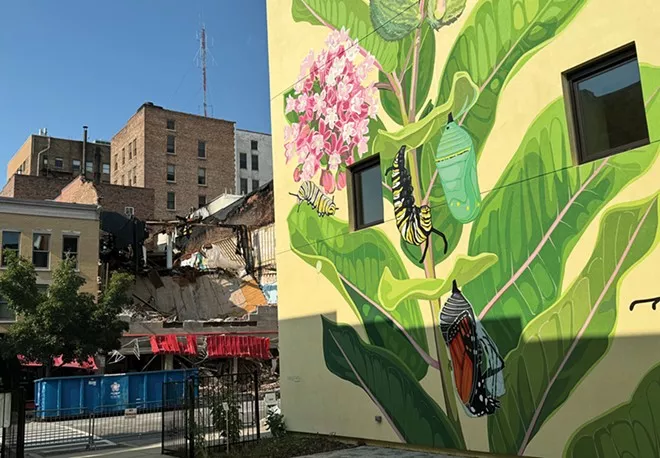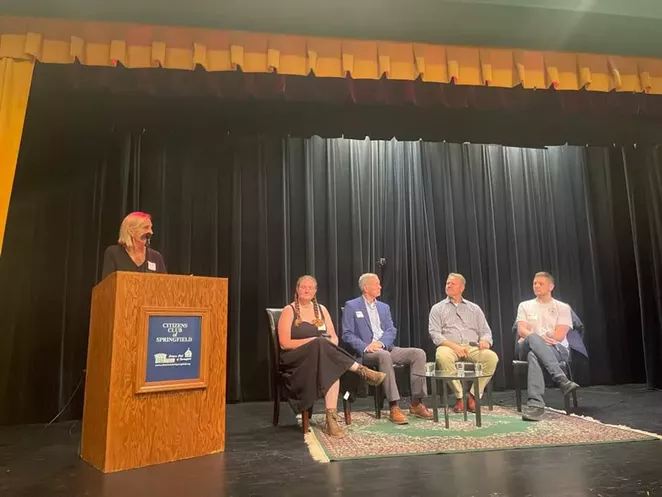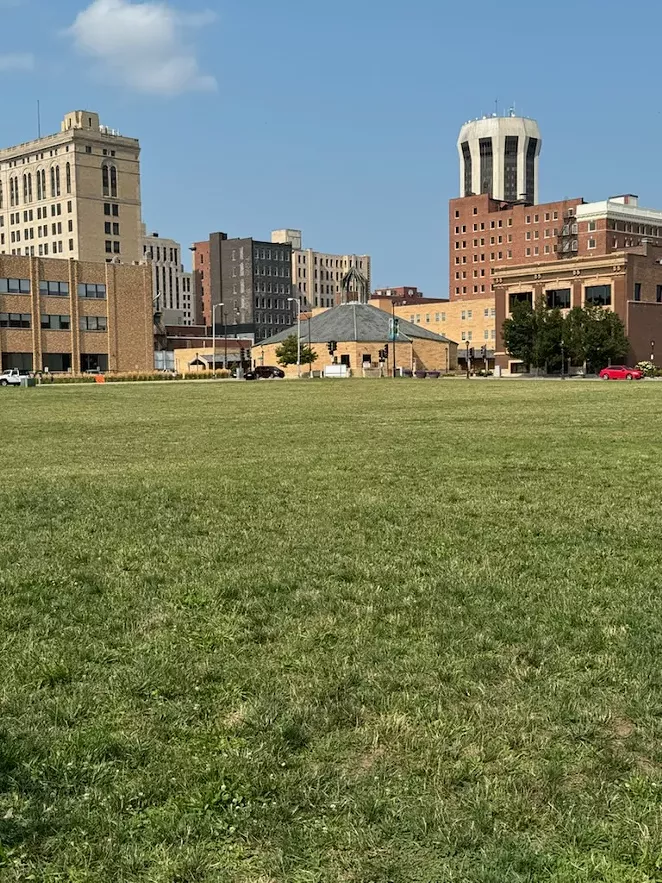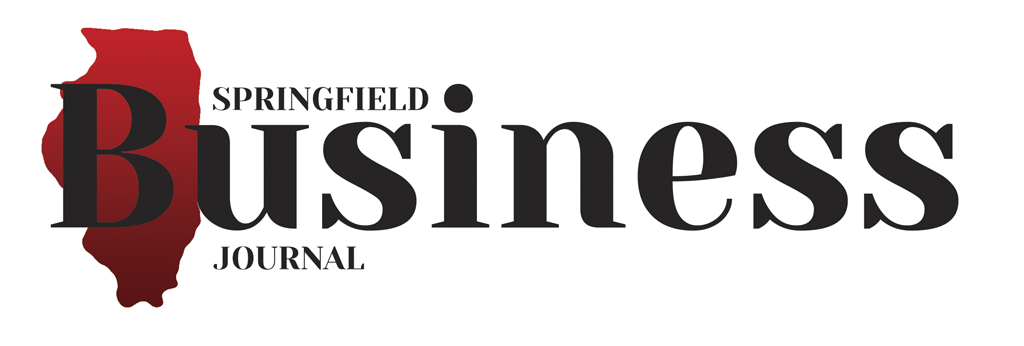
"A revitalized and resilient downtown" was the No. 1 initiative in The Next 10, A Community Visioning Plan for Greater Springfield released by the Community Foundation for the Land of Lincoln in spring 2021. The report described downtown as "the heart of the community and region, the seat of state and local government, our cultural center and the stage for our living history." It noted that downtown uses have shifted over the decades and "to act thoughtfully, we must plan and reimagine."
The June 19 fire on Adams Street between Fourth and Fifth streets brought increased attention to downtown and has raised questions about what will emerge from this unfortunate event. This small segment of downtown has been a bright spot where local businesses and organizations collaborate. They are known collectively and affectionately as the "Adams Family."
Now both devastation and inspiration are on full display in that section of Adams Street. Wreckage from the fire – a collapsed building adjacent to the shuttered Café Moxo – dominates the north side of Adams Street. Across the street at the Kidzeum's entrance is a new bold and beautiful Monarch Migrating Mural, part of the Route 66 Monarch Flyway and Mural Trail.
With these starkly contrasting images, now is an opportune time to review what is happening downtown and progress towards a "revitalized and resilient downtown."
"Any disruption has a ripple effect"
Chris Nickell owns the building at 413-415 E. Adams St. that burned and the adjacent buildings to the west that housed Café Moxo (409-411 E. Adams St.). Former Springfield fire marshal Chris Richmond said this was the first major fire in downtown in 40 years.

Nickell describes the interior damage to the Café Moxo building as minor, but an engineering assessment and strategy to stabilize the wall on the east side of Cafe Moxo must be implemented before the fire-damaged building can be demolished. The common wall on the other side of the fire-damaged space is also a factor, since demolition can't occur until decisions are made about the adjacent building, owned by commercial real estate brokers Bill Marriott and Ben Call.
Marriott said he is getting bids for different plans of action and insurance claims are pending. He said his goal is to keep what is safe to keep, but it's a complicated process to determine what is feasible, and nine different insurance agents are involved with the parties impacted by the fire. Final actions will require coordination among engineers, insurance companies, the city and impacted building owners and businesses.
In the meantime, Adams Street is closed to vehicular traffic, the Old Capitol Farmers Market has been relocated closer to the State Capitol, and retail businesses are experiencing the consequences. Krissy Prellwitz owns Itty Bitty Fashion Trunk at 403 E. Adams. She began with a fashion truck at the farmers market in 2015 and opened her current store in November 2017. Although her year-to-date sales for 2024 prior to the fire were trending up 5%, sales this July compared to last July are down 25%.
"The broader downtown is an ecosystem," said Prellwitz. "We all rely on each other, and any disruption has a ripple effect." Shoppers at the farmers market have always been an important part of Prellwitz's customer base, and moving the market even a couple blocks west has had an impact.
Pillsbury site artifacts were another casualty of the fire. They were temporarily housed in the building that burned after being turned into a contemporary art exhibit curated by Robert Mazrim with help from Moving Pillsbury Forward. Mazrim said the Pillsbury exhibit was a model for transitional use of unused space and how cultural and artistic creations can create a buzz, attract new faces to new places and help envision new opportunities.
Many irreplaceable records and objects were destroyed, but about 30% of the collection was pulled from the rubble. Mazrim said there is enough to reconstitute a future exhibit, but where the artifacts will end up is undetermined. For a city known for its history and historic sites, there is no single institution or organization whose responsibility it is to systematically preserve and showcase the tangible objects that tell the diverse stories of local history.
As for Café Moxo, Nickell's goal is to get the popular restaurant back into operation as soon as possible, although it's too soon to have a concrete timeline. He speaks highly of owner Mark Forinash.
"Mark is a wonderful individual and businessman," said Nickell. Forinash is well-known as a champion for downtown and has continued to keep his staff employed doing volunteer work at community organizations since the fire.
"Cafe Moxo stands with downtown, as it's where our roots run deep and our heart beats just a bit stronger," said Forinash. He first started visiting Springfield about 20 years ago to find a location for his business concept and said he fell in love with the streetscape as well as the neighborhood feel. Forinash said he values the relationships he has built with other business owners, community leaders, tourists and residents. "We remain incredibly grateful for this outstanding community," he said.
Despite the current uncertainties, Forinash said he is not considering relocating his business to the west side of Springfield. He said he remains committed to determining next steps to remain a vital part of the downtown community.
The July 26 Citizens Club meeting at the Hoogland Center for the Arts featured a panel discussion about the Adams Street fire with Nickell, Richmond, Elizabeth Wake and Tom Raymond. Wake owns The Wakery, a business adjacent to the fire-damaged buildings, while Tom Raymond had recently opened The Cats' Pyjamas Cat Café in the lower level of the building that caught fire. The Wakery closed temporarily due to loss of power and smoke damage and has now reopened. Raymond is in the process of relocating his business to 524 E. Capitol Ave.
The speakers told how the fire impacted their operations. Nickell described plans being developed to reimagine and reconfigure both indoor and outdoor spaces for Café Moxo. Businesses have come together to support each other. All are grateful for the outpouring of community support and the INB fund established to help those affected by the fire. Twelve residents, seven businesses and one nonprofit were awarded a total of $15,750 in the initial disbursement made almost one month following the fire. A second and final round of funding is planned for early August.
Alderwoman Lakeisha Purchase, who represents much of downtown and the area of the fire, told the Citizens Club it was inspiring to see businesses coming together to talk about solutions and what can be done as a united team.
Long-term opportunities and short-term challenges
Large-scale projects such as the Springfield Rail Improvements Project, which will relocate the Third Street railroad track and eventually allow that corridor to be redeveloped as a greenway, plus renovation of both the old and new Capitol buildings and the former armory building, have the potential for huge impacts to downtown and beyond. In the meantime, foot traffic is a challenge for downtown businesses. This has been exacerbated by the fire and relocating the farmers market several blocks further west.
Carlos Ortega, director of Downtown Springfield, Inc., says the intent is to move the farmers market back to its previous location on Fourth Street once demolition occurs, but there is currently no timetable for that.
Downtown foot traffic is also an issue for businesses beyond Adams Street. Nickell owns multiple buildings downtown and wants to see all of downtown thrive. His wish is for people to be as interested in all of the other downtown buildings that were not on fire.
Michael Higgins has operated Maldaner's restaurant on Sixth Street since 1982 and has seen a lot of changes over the years. The number of state employees working downtown on a daily basis has declined dramatically as multiple administrations have reduced the number of state employees, moved state jobs from Springfield to Chicago and relocated state offices out of downtown. In January, Maldaner's stopped serving lunch because Higgins said there wasn't enough foot traffic downtown. He said Veterans Parkway is his competition, as many Springfield residents eat and shop on the west side and don't venture downtown.
Higgins believes there is much potential for Springfield, and the key question is what will it take to bring that potential to fruition. He has observed other cities taking bold actions to impact the vibrancy of their communities.
"Springfield needs creative thinking, along with the financial commitment and leadership to bring to the surface our creative potential that has not yet been realized," Higgins said.
Out of the ashes
Kidzeum executive director Leah Wilson wrote an opinion piece for Illinois Times ("What a flood taught me about the fire on Adams Street," July 11) challenging Springfield to harness the opportunity inherent in a crisis, based on her experience with the 2008 devastating flood in Cedar Rapids, Iowa. That crisis became a catalyst that led to a vibrancy that had been fading for decades. She cites leadership, unity of vision, talented city planners and community co-creation for making this possible.
The fire on Adams Street is just one of many issues and challenges that, Wilson said, "has left us with a downtown that often feels forgotten. Becoming the city that we all dream of depends on a unified vision for our ambitious plans and the audacity to see them through."
Wilson is an advocate for cities having a strong urban planning department with professional urban planners. Urban planners identify community needs and help guide both short and long-term development that addresses economic, social, environmental and other issues. That was key to the transformation in Cedar Rapids.
"One could argue that Wabash Avenue is the new Main Street of Springfield," said Wilson. "Meanwhile, our formerly robust downtown has become a fragile ecosystem that often seems to be teetering on the edge of extinction. A planning department with a tight grasp on the long-term vision for our city would bring expertise and resources that we need to correct that situation. Not that we should abandon Wabash – strip malls are convenient but I would argue that if we want to be a destination city with a memorable experience, urban planning is key to revitalizing our downtown core and better connecting it to our unique neighborhoods and historic sites."
A blueprint for the future
The Next 10 called for development of a downtown master plan. In response the city of Springfield, Community Foundation, Springfield-Sangamon Growth Alliance, Downtown Springfield, Inc. and Mid-Illinois Medical District joined forces to fund the development of an integrated master plan for the medical district and downtown. Houseal Lavigne, a Chicago-based urban planning and geospatial design firm, was selected to guide the process.
The coalition hosted a visioning workshop on May 18, 2023, to facilitate community input. Topics included: infill/redevelopment opportunities; vehicular transportation; bike/pedestrian connections; beautification; parks, open space, gathering areas, plazas; and signage.
Initially the plan was scheduled to be completed by the end of 2023. A draft has been developed but not yet released to the public, and that timing is up to the city. Mayor Misty Buscher told Illinois Times it is important for people to have the opportunity to provide input on the draft plan and that the plan is feasible to implement in phases.
The city is in the process of scheduling the final community input meeting with Houseal Lavigne, along with presentations to the Citizens Club and City Council.
"We at the city understand that Downtown Springfield has never had a master plan, and we also appreciate the opportunity it affords development by including the Mid-Illinois Medical District boundaries," said Val Yazell, director of the city's Office of Planning and Economic Development. "Hundreds of our citizens weighed in on issues of concern and we have been carefully reviewing the draft as it could serve as the foundational planning document for the city center. We plan to finalize it with the consultants and release it to the public this fall."
Yazell also said the Mid-Illinois Medical District Act requires the establishment of an advisory council consisting of two representatives appointed by the mayor. The statute specifies the master plan shall not take effect until it has been approved by the advisory council and the Springfield City Council. "The mayor has determined that we need a representative from the medical district and from the downtown area," said Yazell. "Two individuals have been approached, and we are awaiting their response to serve."
Meanwhile, many are awaiting the final version of the downtown master plan. "The Community Foundation is eager for the completion of the Downtown and Medical District Master Plan, which provides a great road map for the future," said John Stremsterfer, CFLL president and CEO.
Others echo the importance of having a plan around which people can unite. "Outside investment is frozen because we don't have a cohesive plan for downtown," said Chris Richmond, president of Moving Pillsbury Forward.
Ryan McCrady, president and CEO of the Springfield Sangamon Growth Alliance, said a master plan is important to help drive goals, show how the community has come together and can be taken to developers to spur private investment. As a former Decatur city manager, McCrady saw the benefits of a master plan in determining a long-term vision, tracking investments and showing what success looks like. "Master plans are not made to happen overnight," said McCrady.
Although the plan is not yet final, the city used the draft to apply for state funding from the Department of Commerce and Economic Opportunity to improve streetscaping, fix sidewalks and curbs, upgrade lighting and landscaping and enhance wayfinding and pedestrian entrances. The city recently applied for $1,987,305 from the Research in Illinois to Spur Economic Recovery (RISE) and Rebuild Downtown and Mainstreet Program (RDMS) grant programs.
Buscher told Illinois Times it is difficult to attract new businesses or redevelopment when the cost to rehabilitate buildings is unknown. She intends to explore additional funding, such as a brownfield grant, to assess empty downtown buildings and determine what issues need to be addressed – such as asbestos, lead paint or sprinklers – and what it would cost.
Given all the big issues on the horizon for Springfield – redevelopment of the North Mansion Block, Springfield Rail Improvements Project, Third Street Greenway, expansion of the BOS Center, national park designation of the 1908 Race Riot site and downtown hotel renovations – a common refrain over many years has been a call for a city planner. The concern is that in the absence of professional staff trained in urban planning, efforts are carried out in a piecemeal fashion.
The draft master plan for downtown calls for a full-time employee dedicated to implementation. Buscher says she doesn't disagree with having an urban planner, although the crux of everything is funding. Currently, a full-time position related to the downtown master plan is not budgeted. Yazell said the Office of Planning and Economic Development has already taken some steps outlined in the plan by rebuilding the office to be more responsive and effective and just last week posted a professional planner position.
The position description is to "develop, maintain and direct a comprehensive planning program for the city of Springfield." Qualifications include experience in business, public administration, planning or a related field. Yazell said there are many areas of Springfield that need attention, and this position is intended to help the city provide more in-depth analysis and focused attention on these areas throughout the city.
State funding helps move major projects forward
Buscher is pleased that $4 million was appropriated to the Illinois Department of Natural Resources in the current state budget for "design, construction, improvements and other capital expenditures for the development of the Governor's Mansion block." Details are not yet available, but she said IDNR landscape architects are working on conceptual plans.
Buscher said she has worked to be non-partisan as mayor, as evidenced by the people working in her administration, and has developed a good working relationship with Gov. JB Pritzker and his administration.

Hanson Professional Services completed a Third Street Greenway Feasibility Report in March 2023 with input from a steering committee comprised of government agencies, elected officials and business and community leaders. The county contributed $250,000 for the completion of the feasibility study. Sergio "Satch" Pecori, chair and CEO of Hanson, said there has been tremendous excitement among citizens about this opportunity.
"Our collective goal is to make sure we are ready to act on the Third Street Greenway when the trains are moved," said Pecori.
Mike Mendenhall is Hanson's project manager for the Springfield Rail Improvements Project and Third Street Greenway and has been working closely with the city of Springfield. The city is currently contributing $250,000 to begin the Phase I preliminary engineering process. Hanson is also working with the city on outreach to property owners along the corridor as well as getting feedback from the fire and police departments to continue to refine feasibility plans. Mendenhall said he anticipates holding a public meeting later this fall or early winter to provide an update to the community.
"The No. 1 comment from the public has been, 'Don't just talk about it, get it done'," said Mendenhall. He said Hanson and the city are working together to keep the momentum going.
An environmental assessment is a critical next step. The state of Illinois included $1.3 million for the Third Street Greenway in its most recent budget. Mendenhall said the additional money the city will receive from the state will allow the preliminary engineering process to continue and begin the environmental study for the Third Street Greenway.
Andrea Aggertt, architect of the Capitol, served on the steering committee for the feasibility study. She sees the Third Street Greenway as a pivotal part of connecting downtown and the Capitol complex, which have often operated as two separate entities.
"The Third Street Greenway will break down those barriers and link east to west, from the state Capitol complex to the downtown city center," said Aggertt. "The current and future planned projects on the Capitol complex, along with the Third Street Greenway improvements, will benefit downtown Springfield for residents and visitors. Coordinated wayfinding amongst all projects will provide linkages to sites of interest and promotion of local businesses."
Aggertt is excited about what's happening. "We are stronger when we work together," she said.
Karen Ackerman Witter grew up in Springfield. She shopped downtown as a teenager, worked in the Capitol and other buildings in and around the Capitol complex during her 35-year state government career, and had her wedding rehearsal dinner at Maldaner's in 1979. She is a former associate director of the Illinois State Museum and past president of the Kidzeum board of directors.
